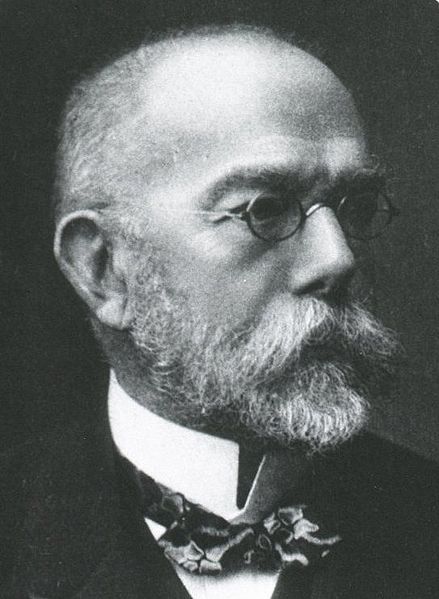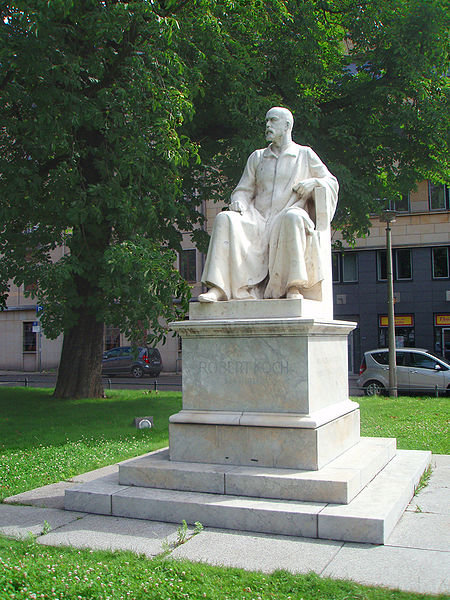<Back to Index>
- Physician Heinrich Hermann Robert Koch, 1843
- Novelist Aleksandr Isayevich Solzhenitsyn, 1918
- Russian Revolutionary Georgi Valentinovich Plekhanov, 1857
PAGE SPONSOR


Heinrich Hermann Robert Koch (11 December 1843 – 27 May 1910) was a Prussian physician. He became famous for isolating Bacillus anthracis (1877), the Tuberculosis bacillus (1882) and the Vibrio cholerae (1883) and for his development of Koch's postulates.
He was
awarded the Nobel Prize in
Physiology or Medicine for
his tuberculosis findings in 1905. He is considered one of the founders
of microbiology,
inspiring such major figures as Paul Ehrlich and Gerhard Domagk. Heinrich
Hermann Robert Koch was born in Clausthal,
Prussia, one of the German states as the son of a mining official. He
studied medicine under Friedrich
Gustav Jakob Henle at
the University of
Göttingen and
graduated in 1866. He then served in the Franco -
Prussian War and
later became district medical officer, Wollstein
(Wolsztyn), Prussian Poland.
Working with very limited resources, he became one of the founders of bacteriology,
the other major figure being Louis Pasteur. After Casimir Davaine showed the direct
transmission of the anthrax bacillus
between cows, Koch studied anthrax more closely. He invented methods to
purify the bacillus from blood samples and grow pure cultures. He found
that, while it could not survive outside a host for long, anthrax built
persisting endospores that could last a long
time. These endospores,
embedded in soil, were the cause of unexplained "spontaneous" outbreaks
of anthrax. Koch published his findings in 1876, and was rewarded with a job at
the Imperial Health Office in Berlin in 1880. In 1881, he urged the sterilization of surgical instruments
using heat. In
Berlin, he improved the methods he used in Wollstein, including
staining and purification techniques, and bacterial growth media,
including agar plates (thanks to the advice of
Angelina and Walther Hesse)
and the
Petri dish, named after its inventor, his assistant Julius Richard
Petri. These devices are still used today. With these
techniques, he was able to discover the bacterium causing tuberculosis (Mycobacterium
tuberculosis) in 1882 (he announced the discovery on 24
March). Tuberculosis was the cause of one in seven deaths in the mid
19th century. In 1883,
Koch worked with a French research team in Alexandria, Egypt,
studying cholera.
Koch identified the vibrio bacterium
that caused cholera, though he never managed to prove it in
experiments. The bacterium had been previously isolated by Italian
anatomist Filippo Pacini in 1854, but his work had
been ignored due to the predominance of the miasma theory
of disease.
Koch was unaware of Pacini's work and made an independent discovery,
and his greater preeminence allowed the discovery to be widely spread
for the benefit of others. In 1965, however, the bacterium was formally
renamed Vibrio
cholera Pacini 1854. In 1885,
he became professor of hygiene at the University of
Berlin, then in 1891 he was made Honorary Professor of the medical faculty
and Director of the new Prussian
Institute for Infectious Diseases (eventually renamed as the Robert Koch
Institute),
a position from which he resigned in 1904. He started traveling around
the world, studying diseases in South Africa, India, and Java. He
visited what is now called the Indian
Veterinary Research Institute (IVRI), Mukteshwar, on request of the then Government of
India to
investigate on cattle plague. The microscope used by him during that
period was kept in the museum maintained by IVRI. Probably
as important as his work on tuberculosis, for which he was awarded a
Nobel Prize (1905), are Koch's
postulates, which say that to establish that an organism
is the cause of a disease,
it must be: Koch's
pupils found the organisms responsible for diphtheria, typhoid, pneumonia, gonorrhoea,
cerebrospinal meningitis, leprosy, bubonic plague, tetanus,
and syphilis,
among others, by using his methods. Robert
Koch died on 27 May 1910 from a heart attack in Baden-Baden,
aged 66. The
crater Koch on the Moon is named after him. The Robert Koch
Prize and
Medal were created to honour Microbiologists who make groundbreaking
discoveries or who contribute to global health in a unique way. The
now defunct Robert Koch Hospital at Koch, Missouri (south of St. Louis,
Missouri), was also named in his honor. A hagiographic account of Koch's career
can be found in the 1939 Nazi propaganda film Robert Koch, der
Bekämpfer des Todes (The
fighter against death), directed by Hans Steinhoff and starring Emil Jannings as Koch. Because
the construction efforts were jeopardized by malaria outbreaks on Veliki Brijun
Island which occurred during summer months, at the turn of the
century, the Austrian steel industrialist Paul
Kupelweiser had invited the famous physician Robert Koch, who at the
time studied different forms of malaria and quinine
based treatments. Koch accepted the invitation and spent two years,
from 1900 to 1902, on the Brijuni
Islands Archipelago.
According to Koch’s instructions, all the ponds and swamps where malaria -
carrying mosquitoes hatched
were reclaimed and patients were treated with quinine. Malaria was
thus eradicated by 1902 and Kupelwieser erected a monument to Koch,
which still stands in vicinity of the 15th century Church of St. German
on Veliki Brijun
Island.